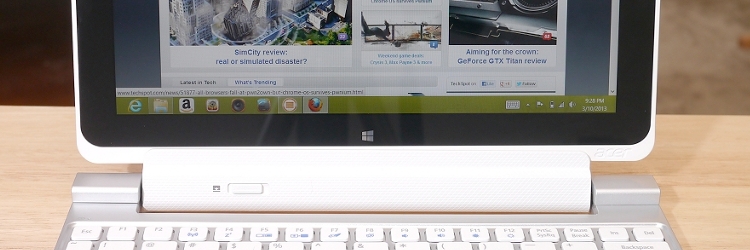Performance, Who Is It For?
The Acer W5 ships with a full copy of Windows 8. I've worked with Microsoft's latest operating system during my time with the Lenovo Yoga 13, a convertible notebook / tablet hybrid. As mentioned in that review, Windows 8 (partially) offers a new UI experience that will take some time to get used to, but as you will quickly realize the operating system feels right at home on a hybrid like the Iconia.
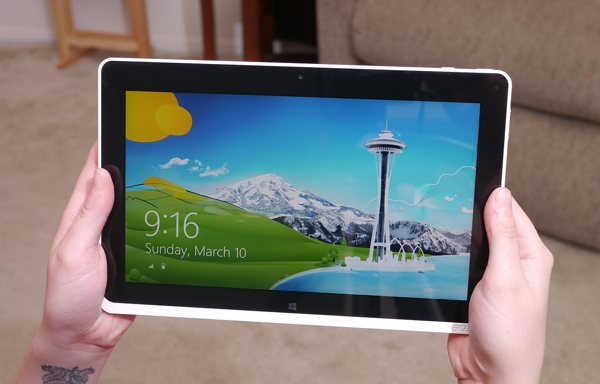
The W5 was able to fully boot into Windows in just 18 seconds - it's not quite the 11 seconds that the Yoga 13 was capable of but given the slower hardware, it's still impressive. One can credit the combination of Windows 8 for the speedy boot time and perhaps to a lesser extent, the flash storage.
As I typically do with a new computer, I navigated over to the add/remove programs list to see which software I would jettison from the get-go; in other words, bloatware. I was pleasantly surprised to find less than half a dozen programs fell into this category.
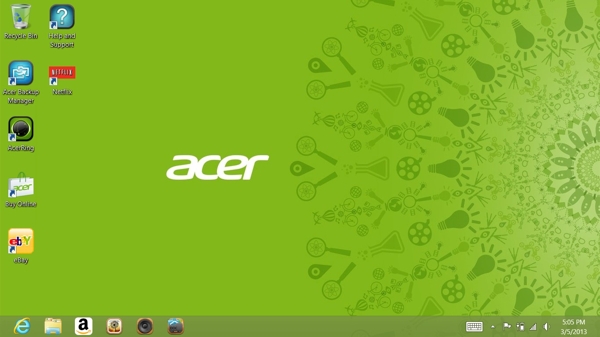
Given this new platform, we were forced to modify our benchmarking procedures slightly. PCMark Vantage refused to give an overall score no matter how hard I tried. We are also doing away with our "real-world" web-browsing battery test in favor of the much more standardized Powermark application. All of our other testing procedures have been carried over from Windows 7.
Evidently, we have compared against 'full' laptop machines also running Windows 8, which offer considerably more horsepower and are priced at around $1,000. So, performance-wise, it's not a fair comparison, but we wanted to give you precisely the perspective of what you are looking at if you decide to go with a hybrid vs. a (touch enabled) laptop, both capable of running full Windows.
Benchmarks Results
| Synthetic Tests | Iconia W5 | Aspire S7 | Yoga 13 |
| 3DMark 06 | |||
| 3DMark Score | 461 3DMarks | 5000 3DMarks | 4393 3DMarks |
| Application Tests | Iconia W5 | Aspire S7 | Yoga 13 |
| iTunes Encoding Test | 6 min 12 sec | 1 min 20 sec | 1 min 25 sec |
| File Transfer Test | |||
| Small files | 5 min 52 sec | 16 sec | 24 sec |
| Large file | 1 min 51 sec | 17 sec | 22 sec |
The iTunes encoding tests consist of converting 14 MP3s (119MB) to 128Kbps ACC files and measuring the operation's duration in seconds. For file transfers, we measure how long it takes to copy two sets of files from one location to another on the same hard drive. On the small files test we transfer 557 MP3s, totaling 2.56GB. For the large file, these same MP3s were zipped into a single file measuring 2.52GB.
|
|
|
Using the Iconia W510
Acer pretty much nailed it with the aesthetics of the W5. The dimensions, weight and overall feel of the slate is top-notch. Nothing about the system feels cheap or as if it was a second thought. The same can be said for the keyboard dock as the hinge feels very sturdy and the keyboard is acceptable in terms of rigidity. Do note that, like netbooks before it, the board is a bit cramped which can be a problem if you have larger hands.
The W5 utilizes 64GB of flash storage space which going into the review, I assumed would be rather speedy. Perhaps it wouldn't be quite as fast as a dedicated solid state drive but I certainly expected more out of it. If synthetic benchmarks didn't paint a clear enough picture, the real-world copy tests certainly highlighted the system's storage shortcomings.
The large file transfer test was somewhat acceptable but taking nearly six minutes to complete the small file transfer test is unacceptable. In fact, it's the slowest storage solution I have tested to date. Simply put, something is certainly off here.
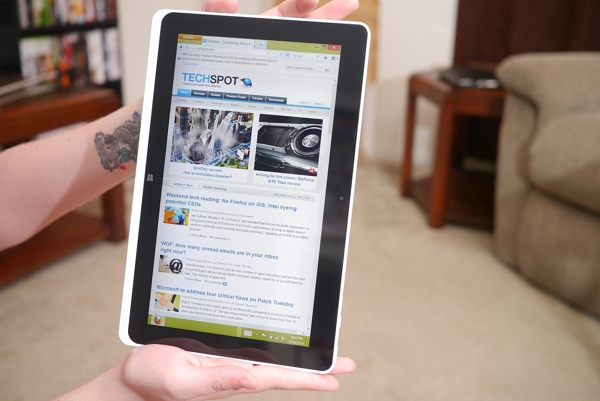
As for capacity, 64GB of storage is plenty in tablet talk but it's not really a whole lot for a true PC. In fact, I had to uninstall one of the benchmarking applications to free up space for one of the game installs as the system simply ran out of storage. This may or may not be something to consider as there are multiple cloud storage options available but ultimately this will come down to personal preference. The upside, however, is that you can use an external USB hard drive with the W5 or even a micro-SD card for added storage.
I conducted our standard notebook battery tests on the W510. Our video playback test consists of looping a 720p rip of the movie Inception at full screen with max brightness and Wi-Fi disabled. This is a taxing test that resulted in 8 hours and 31 minutes of battery life.
Our Powermark test consisted of running the application at default settings under the "Balanced" profile which gives a mixed workload of web browsing, word processing, gaming and video playback. This test was also run at max screen brightness and resulted in 6 hours and 15 minutes of uptime.
Keep in mind that the battery tests were run with the tablet not attached to the keyboard dock. When docked, Acer claims you can expect up to 18 hours of battery life. Based on our estimates you can nearly double the W510's run time when docked, and quite possibly reach the 18-hour mark if you are conservative about screen brightness and you are not running demanding applications.
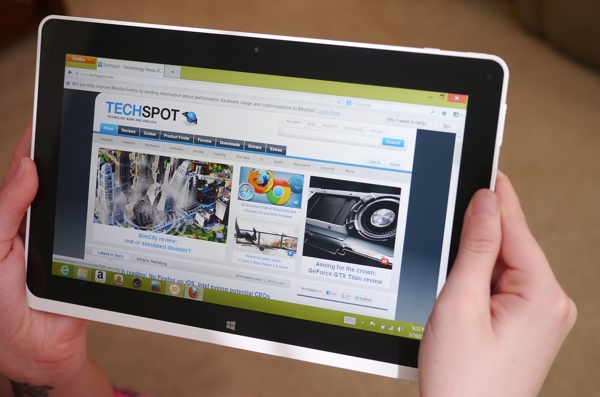
Our YouTube 4K resolution video test was unable to run on the W510 as it was simply too taxing for the lowly Atom processor. CPU usage pegged at 99 percent and the video was reduced to a frame by frame photo slideshow. However, 1080p video was possible with the tablet and for the most part the system was able to keep pace. There were only a few instances where I noticed video playback seemed to stutter.
The dual speaker system was a little better than expected but still nothing to write home about. The speakers get loud enough to enjoy music and videos without distortion but as you'd expect, there's virtually no bass to speak of. They are about on par with a quality set of notebook speakers in terms of quality and loudness.
If you were hoping to play non-mobile games on the W510, keep looking. The internal hardware simply wasn't able to keep up with any of the PC games I tried, even on the most basic graphical settings. Mobile-inspired games, however, are possible but that's about it.
One of the few good things about the processor inside the slate is that it doesn't need to be actively cooled. As such, the slate remained silent even under full load. The top right side of the tablet does get a bit warm with extended use but it's nothing to be concerned with.
One of the real highlights of the W510 is the display. At 1,366 x 768, the display certainly doesn't carry a massive PPI but it looks fantastic from all angles. Color reproduction is outstanding and everything looked vibrant and alive. A number of other manufacturers could learn a thing or two about display selection from Acer.
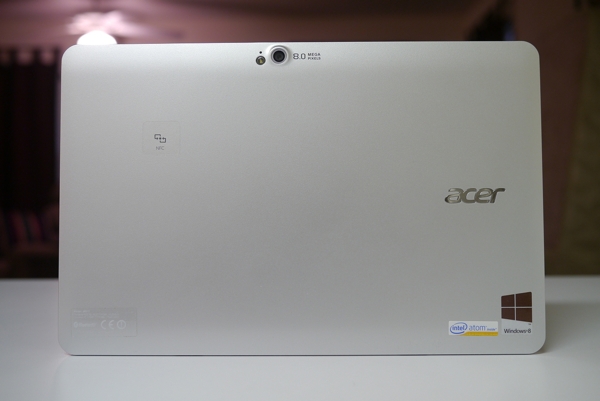
One thing worth pointing out, unlike a traditional notebook, the screen doesn't turn off when you close the lid while docked. You'll instead need to remember to press the power button each time you are done with the slate in notebook mode.
A hybrid like this is the perfect platform for Windows 8 to really showcase its potential but unfortunately, the Intel Atom processor holds the system back. As a tablet, the W510 shines but with a full version of Windows 8 controlling things, you're often compelled to do more than simple tablet tasks at which time the processor's lack of horsepower quickly becomes evident.
The bottom line is that as a PC, it still feels like a slow and limited netbook, and considering its $650 price tag that's just too much of a compromise. With that kind of budget you're likely better off getting a better notebook or better tablet. Or, if you can spring the extra $250-$350, the Core i5 equipped Surface Pro will run Windows 8 without the slowdowns.
score
Pros: Solid build quality, excellent battery life and quality display. Windows 8 feels at home on a hybrid like this.
Cons: Atom processor holds the system back in terms of performance, cramped keyboard.
